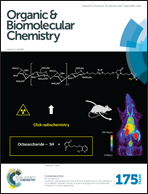Development of a stable phosphoarginine analog for producing phosphoarginine antibodies†
Abstract
Protein phosphorylation is one of the most common and extensively studied post-translational modifications (PTMs). Compared to the O-phosphorylation on Ser, Thr and Tyr residues, our understanding of arginine phosphorylation is relatively limited, both in prokaryotes and eukaryotes, due to the intrinsic instability of phosphoarginine (pArg) and the lack of a feasible method to produce anti-pArg antibodies. We report the design and synthesis of a stable pArg analog, in which the labile N–P bond is replaced with a non-hydrolyzable C–P bond. Significantly, this analog was successfully used as a hapten to raise an immune response and the first mouse polyclonal antibody that specifically recognizes pArg-containing peptides and proteins was produced using analog-KLH conjugated as the immunogen. The generated antibody shows excellent specificity towards pArg-containing peptides and proteins, and could be used for a variety of biological detection methods. This provides us an invaluable tool to unravel the mystery of the biological function of pArg.


 Please wait while we load your content...
Please wait while we load your content...